Amresco 0376-50G PHENOLPHTHALEIN 酚酞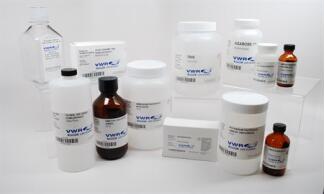
日度归档:2024年11月16日
康宁corning 3492 TW COL,24MM,3.0UM,PTFE,S,IND, Transwell-COL-膜嵌套 24mm直径 3.0um孔径PTFE(聚四氟乙烯)膜 COL表面 灭菌 单个包装 1个/包
康宁corning 3492 TW COL,24MM,3.0UM,PTFE,S,IND,
Transwell-COL-膜嵌套 24mm直径 3.0um孔径PTFE(聚四氟乙烯)膜 COL表面 灭菌 单个包装 1个/包 24包/箱 3962.54
Amresco 硫酸庆大霉素0304
Amresco 硫酸庆大霉素- 0304-10g
英文名:Gentamycin Sulfate;Gentamicin;Ganamycin;Gentalin;Cidomycin
中文名:硫酸庆大霉素;硫酸正泰霉素;庆大霉素
货号:0304-10G
品牌:AMRESCO
保存温度:2-8˚ C
|
品名
|
产地
|
货号
|
规格
|
单价
|
备注
|
|
Gentamycin Sulfate硫酸庆大霉素
|
Amresco
|
0304
|
1G
|
询价
|
现货
|
|
Gentamycin Sulfate硫酸庆大霉素
|
Amresco
|
0304
|
5G
|
询价
|
现货
|
硫酸庆大霉素
分子式:C21H43N5O7.H2SO4 分子量:575.67
物理性状及指标:
外观:……………………白色或类白色粉末
熔点:……………………218-237 °C
溶解性:…………………在水(115 mg/ml,25 °C)中易溶,在乙醇(<1 mg/ml,25 °C)、丙酮、三氯甲烷或乙醚中不溶
干燥失重:………………≤18.0%
含量:……………………≥590IU
IC50:……………………半数致死剂量 (LD50) 经口 – 大鼠 – > 5,000 mg
用途及描述:科研试剂,广泛应用于分子生物学,药理学等科研方面。硫酸庆大霉素为氨基糖苷类抗生素。对各种革兰阴性细菌及革兰阳性细菌都有良好的抗菌作用,对各种肠杆菌科细菌如大肠埃希菌、克雷伯菌属、变形杆菌属、沙门菌属、志贺菌属、肠杆菌属、沙雷菌属及铜绿假单胞菌等有良好作用。奈瑟菌属和流感嗜血杆菌对本品中度敏感。对布鲁菌属、鼠疫杆菌、不动杆菌属、胎儿弯曲菌也有一定作用。对葡萄球菌属(包括金黄色葡萄球菌和凝固酶阴性葡萄球菌)中的甲氧西林敏感菌株约80%有良好抗菌作用,但甲氧西林耐药株则对本品多数耐药。对链球菌属和肺炎链球菌的作用较差,肠球菌属则对本品大多耐药。本品与β内酰胺类合用时,多数可获得协同抗菌作用。本品的作用机制是与细菌核糖体30S亚单位结合,抑制细菌蛋白质的合成。
储存条件:室温,避光防潮密闭干燥。
康宁corning 9102 PLT,8WL STRIP,FB,WO/LID,S,IND, 96孔可拆板 8孔排管 透明 TC表面 灭菌 1个/包
康宁corning 9102 PLT,8WL STRIP,FB,WO/LID,S,IND,
96孔可拆板 8孔排管 透明 TC表面 灭菌 1个/包 50包/箱 3411.42
无DMSO细胞冻存液
| 产品编号 | 产品名称 | 产品规格 | 产品等级 | 产品价格 |
| CPL-A1 | CryoScarless DMSO-Free 无DMSO细胞冻存液 |
100 ml | – | – |
无DMSO细胞冻存液
CryoScarless DMSO-Free
CryoScarless DMSO-Free 是一种无血清、无DMSO 的冻存液,用于细胞的长期低温(-80℃或液氮)保存。
◆特点•优势
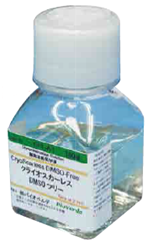
● 无血清、无DMSO
● 高细胞活力、无DMSO 和无血清来源蛋白产生细胞毒性的风险
● 90% 以上的细胞冻融后仍具有一致性和高细胞活力
● 可维持干细胞分化能力
● 无细菌、真菌和支原体污染
● 保质期长,4℃下可保存2 年
◆案例•应用
对比数据
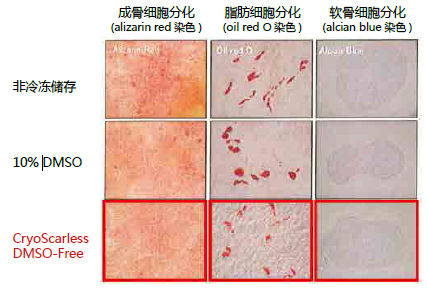
大鼠间充质干细胞冻存复苏后的分化情况
结果显示大鼠间充质干细胞用CryoScarless DMSOFree冻存后依然保持良好的细胞全能性
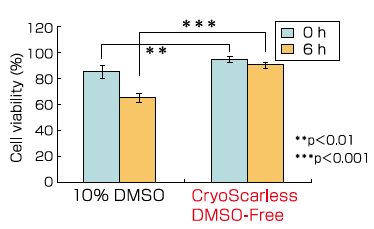
鼠间充质干细胞冻存复苏后细胞活力检测
用CryoScarless DMSO-Free 冻存的细胞活力明显高于含10%DMSO的细胞冻存液。
0h:复苏后立即检测6h:细胞粘附之后
应用
| Cell type | Cell viability(%) |
| L929 | 97.5±1.2 |
| MG63 | 93.1±2.3 |
| HT1080 | 90.2±4.3 |
| Colon26 | 92.3±2.3 |
| B16F1 | 94.2±0.6 |
| KB | 91.8±0.9 |
| Caco2 | 93.7±1.9 |
| MC3T3 | 94.4±0.5 |
| JurkatE6-1 | 88.9±0.4 |
| HUVEC | 89.9±0.4 |
| HCAEC | 90.1±1.6 |
| MEF | 94.4±0.8 |
| hACh | 93.5±0.7 |
* 细胞用CryoScarless DMSO-Free 冻存液-80℃保存3个月,复苏细胞24小时后进行活力检测。
实验操作步骤
1. 离心培养细胞,去上清;
2. 用CryoScarless DMSO-Free 冻存液重悬细胞(1mL含5×105-106个细胞),每管分装1mL;
3. -80℃低温冻存;
* 为了长期保存,可以置于液氮罐中。
4. 取出细胞,37℃恒温水浴锅快速溶解,立即用10mL的适当培养基稀释,轻轻混匀。
Thermo官网Thermo Fisher赛默飞中国代理商
关东化学株式会社代理 上海金畔生物科技有限公司
日本关东化学代理商 日本KANTO化学中国代理商
日本关东化学官网 日本KANTO化学中国代理
日本关东化学官网 日本KANTO化学中国代理
日本KANTO关东化学代理商
日本关东化学试剂代理商
日本关东化学试剂代理商 日本关东化学
关东化学株式会社是日本著名的综合试剂厂家它的高质量产品在国际上享有极高的声誉。不仅在中国国内 多年来在日本国内、亚洲地区、美国、欧洲等地都深受厚爱。为了保证所有试剂产品的质量 关东化学株式会社的全工厂都取得了ISO 9001和ISO/IEC 17025质量管理体系认证 建立了严格的品质管理体系。1998年 全工厂又在日本试剂行业中率先取得了ISO 14001环境管理体系认证。关东化学株式会社不仅是一家拥有先端技术的生产企业也是一家重视环境安全以及人类社会健康和谐的可信赖企业。
无论是一般试剂还是特殊试剂、从零售到大量批发 我公司都会竭尽全力地为您提供优质服务、满足您的需求。
日本关东试剂 日本关东化学 日本关东化学株式 关东化学 关东化学株式会社 化学试剂
www.boykyo.com
上海金畔同时代理日本日水培养基系列 在生命科学领域,康宁为业界提供了丰富的实验室和生物医药生产研发的产品。上海金畔生物代理Nissui(日水)培养基产品,在这里要感谢广大客户多年来对上海金畔生物科技有限公司的支持和厚爱,我们将一如既往的为广大客户带来Nissui(日水)培养基高品质的产品和服务,欢迎广大新老客户来电咨询。 Nissui日水代理,Nissui日水上海代理,Nissui日水北京代理,Nissui日水广州代理
康宁corning 4864 TIPS,200UL,NAT,PP,S,RK,96/960 通用吸头 1-200ul 自然色 盒装 灭菌 96个/包
康宁corning 4864 TIPS,200UL,NAT,PP,S,RK,96/960
通用吸头 1-200ul 自然色 盒装 灭菌 96个/包 10包/箱 638.5
乙酸检测试剂盒[乙酸激酶法] Acetic Acid (Acetate Kinase Manual Format) 货号:K-ACETRM Megazyme中文站
乙酸检测试剂盒[乙酸激酶法]
英文名:Acetic Acid (Acetate Kinase Manual Format)
货号:K-ACETRM
规格:72 assays (manual) / 720 assays (microplate)
分析物意义: 常见食品的组分
Megazyme检测试剂盒优点: K-ACETRM 是运用AK和磷酸乙酰转移酶的新型、快速的手工检测试剂盒。试剂稳定
K-ACETAK (自动) 是一种以乙酸激酶(AK)为基础的,新型、稳定、快速的检测试剂盒,具有良好的线性。
This rapid and reliable manual acetic acid kit is simple to perform (only two absorbance readings required), and because a true end-point is measured, does not involve complicated calculations like other kits. This product is very stable both during storage and use (> 2 years), has extended linearity (compared to ACS based kits), contains PVP to prevent tannin inhibition, and is performed at a relatively low pH (7.4), thus minimising ester hydrolysis related interference. This method is suitable for the measurement of acetic acid/acetate in foods, beverages and other materials. Content:72 assays
乙酸检测试剂盒[乙酸激酶法]
Manual format UV-method for the determination of Acetic Acid
in foodstuffs, beverages and other materials
Principle:
(acetate kinase)
(1) Acetic acid + ATP → acetyl-phosphate + ADP
(phosphotransacetylase)
(2) Acetyl-phosphate + CoA → acetyl-CoA + Pi
(pyruvate kinase)
(3) ADP + PEP → ATP + pyruvate
(D-lactate dehydrogenase)
(4) Pyruvate + NADH + H+ → D-lactic acid + NAD+
Kit size: 72 assays (manual) / 720 (microplate)
Method: Spectrophotometric at 340 nm
Reaction time: ~ 4 min
Detection limit: 0.063 mg/L
Application examples:
Wine, beer, fruit and fruit juices, soft drinks, vinegar, vegetables,
pickles, dairy products (e.g. cheese), meat, fish, bread, bakery products
(and baking agents), ketchup, soy sauce, mayonnaise, dressings, paper
(and cardboard), tea, pharmaceuticals (e.g. infusion solutions), feed
and other materials (e.g. biological cultures, samples, etc.)
Method recognition: Improved method
Advantages
- Improved assay format (only two absorbance readings required)
- All reagents stable for > 2 years after preparation
- PVP incorporated to prevent tannin inhibition
- Very rapid reaction (~ 4 min)
- Mega-Calc™ software tool is available from our website for hassle-free raw data processing
- Very competitive price (cost per test)
- Suitable for Manual and Microplate formats
Q1. Is the acetic acid kit specific for acetate?
Propionate may react more slowly than acetate.
Q2. Is the K-ACETRM Assay Kit suitable for measurement using cell culture media samples?
Yes, assuming that the concentration of the analyte in the sample (after sample preparation) is above the limit of detection for the kit. It may be sufficient to use the sample directly in the assay after clarification by centrifugation / filtering followed but dilution (if required) in distilled water.
Q3. Should the pH of the sample be adjusted even for samples in acidic media?
The pH of the assay solution after the sample is added should be the same as that of the assay buffer that is supplied with the kit.
Low sample volumes (e.g. 0.1 mL) are not likely to affect the pH of the assay solution and therefore may not require pH adjustment.
Samples above 0.1 mL are more likely to affect the pH of the assay solution and therefore the pH of these samples should be adjusted as described in the data booklet, prior to addition to the assay.
Q4. Sometimes a negative absorbance change is obtained for the blank samples, is this normal? Should the real value (negative absorbance change) or “0” be used in the calculation of results?
Sometimes the addition of the last assay component can cause a small negative absorbance change in the blank samples due to a dilution effect and in such cases it is recommended that the real absorbance values be used in the calculation of results.
Q5. Does the decolourising preparation remove some VA during the process?
No, however the sample preparation process can be tested by adding a known amount of acetic acid standard and assessing the recovery of this.
Q6. Can acetic acid be measured in culture/fermentation media?
Acetic acid in liquid cell culture media/supernatants or fermentation samples can be determined without any sample treatment (except clarification by centrifugation or filtration) and appropriate dilution in distilled water.
Q7. There is an issue with the performance of the kit; the results are not as expected.
If you suspect that the Megazyme test kit is not performing as expected such that expected results are not obtained please do the following:
- Ensure that you have tested the standard sample that is supplied with the Megazyme test kit.
- Send the results of the kit standard, blank samples and the results obtained for your sample, in the relevant MegaCalc spreadsheet (if available) to Megazyme (cs@megazyme.com). Where available the relevant MegaCalc spreadsheet can be downloaded from where the product appears on the Megazyme website.
- State the kit lot number being used (this is found on the outside of the kit box).
- State which assay format was used (refer to the relevant page in the kit booklet if necessary).
- State exact details of any modifications to the standard procedure that is provided by Megazyme.
- State the sample type and describe the sample preparation steps if applicable.
Q8. What are the major the differences between the various acetic acid test kits?
Megazyme produces 4 acetic acid test kits:
K-ACET: uses the traditional ACS reaction. Manual format for use with spectrophotometers.
K-ACETAF: uses the traditional ACS reaction. Automated format for use with auto-analysers.
K-ACETAK: uses the more recently developed and more rapid acetate kinase reaction. Automated format for use with auto-analysers.
K-ACETRM: uses the more recently developed and more rapid acetate kinase reaction. Manual format for use with spectrophotometers.
Q9. Which acetic acid kit is recommended for a 96-well microplate format?
Auto-analysers use ~ 0.315 mL reaction volumes and pathlengths between 4-8 mm which is similar to a standard 96-well microplate where a 0.315 mL reaction volume would give a pathlength of ~ 6-7 mm. Therefore K-ACETAK or K-ACETAF can be used directly in a 96-well microplate format with minimal assay optimisation.
If preferred, K-ACET or K-ACETRM may also be easily converted for use in a 96-well microplate format. Basically, the assay volumes for the cuvette format must be reduced approximately 10-fold for use in a 96-well microplate. However, some assay optimisation may be required (e.g. increased enzyme concentration etc.) and unlike the cuvette which has a set pathlength of 1 cm, the pathlength in the microplate is dependent upon the volume of liquid in the well. Therefore to enable the calculation of the amount of analyte in the samples from tests performed in the microplate format one of the following must be done:
- The easiest method is to use a microplate reader that has a pathlength conversion capability (i.e. the microplate reader can detect the pathlength of each well and convert the individual readings to a 1 cm pathlength). This will allow values to be calculated using the MegaCalc calculation software which can be found where the product is located on the Megazyme website.
- Perform a standard curve of the analyte on each microplate that contains test samples and calculate the result of the test samples from the calibration curve (concentration of analyte versus absorbance).
- Perform a standard curve of the analyte in both the cuvette format (i.e. with a 1 cm pathlength) and the 96-well microplate format and use these results to obtain a mean conversion factor between the cuvette values and the microplate values.
Acetic Acid Kit Recommendation For Microplate Format:
Either K-ACETRM or K-ACETAK is recommended for use in a 96-well microplate format and the main advantages / disadvantages are described below:
K-ACETRM:
The assay volumes of this kit should be reduced by 10-fold for use in a 96-well microplate format (some assay optimisation may be required, e.g. increased enzyme concentration etc.).
The calculation of results is achieved as outlined above in either of points 1, 2 or 3.
Q10. The pH of my sample is low (pH ~ 3.0), do I need to adjust this before I use the sample in the kit assay?
The final pH of the kit assay after the sample is added should not change from what it should be (as stated in the kit for the assay buffer). If it does change then the sample will require pH adjustment. In most cases the sample volume being used is low relative to the final assay volume and in this case the pH of the kit assay is unlikely to be affected.
Q11. How can I work out how much sample to extract and what dilution of my sample should be used in the kit assay?
Where the amount of analyte in a liquid sample is unknown, it is recommended that a range of sample dilutions are prepared with the aim of obtaining an absorbance change in the assay that is within the linear range.
Where solid samples are analysed, the weight of sample per volume of water used for sample extraction/preparation can be altered to suit, as can the dilution of the extracted sample prior to the addition of the assay, as per liquid samples.
Q12. Can you explain, step by step, how to follow the method and perform the kit assay?
For users who are not familiar with how to use the Megazyme tests kits then it is recommended that they follow this example, e.g. D-Fructose/D-Glucose Assay kit K-FRUGL (http://secure.megazyme.com/D-Fructose-D-Glucose-Assay-Kit):
1. The kit components are listed on pages 2-3 of the kit booklet.
2. Prepare the kit reagents as described on page 3.
3. For separate measurements of glucose and fructose follow procedure A on page 4.
4. Pipette the volumes listed for water, sample, solution 1 and solution 2 into 3 mL, 1 cm pathlength cuvettes. Duplicate sample assays and duplicate blanks are recommended. Mix the contents of each cuvette by inversion (seal the cuvette using parafilm or a plastic cuvette cap – do not use a finger) then after ~3 min record the first absorbance reading of each cuvette at 340 nm (this is reading A1).
5. Then add suspension 3 and mix the contents of each cuvette by inversion. Incubate for 5 minutes then record the absorbance reading of each cuvette at 340 nm (this is reading A2). NB. It is essential that the reaction is compete. To assess this, record the absorbances at ~ 2 minute intervals and until the absorbance plateaus. A stable absorbance indicates that the reaction is complete. If the absorbance continues to increase then continue to record absorbances until it plateaus and only then record absorbance reading A2.
6. Then add suspension 4 and mix the contents of each cuvette by inversion. Incubate for 5 minutes then take absorbance reading of each cuvette at 340 nm (this is reading A3). NB. As above, assess that the reaction has completed by take subsequent readings at ~2 min intervals.
7. For simple, automated results analysis, input the absorbance readings (A1, A2, A3) for samples and blanks into the K-FRUGL MegaCalc.
To ensure that the assay is working, and being performed correctly it is recommend that the test is performed using the standard sample that is provided with the kit and to obtain the expected values before proceeding to test real samples.
It is recommend that new users also watch this video which highlights how to perform the assays.
Many of the other Megazyme test kits follow a similar format.
Q13. I have some doubts about the appearance/quality of a kit component what should be done?
If there are any concerns with any kit components, the first thing to do is to test the standard sample (control sample) that is supplied with the kit and ensure that the expected value (within the accepted variation) is obtained before testing any precious samples. This must be done using the procedure provided in the kit booklet without any modifications to the procedure. If there are still doubts about the results using the standard sample in the kit then send example results in the MegaCalc spread sheet to your product supplier (Megazyme or your local Megazyme distributor).
Q14. Can the sensitivity of the kit assay be increased?
For samples with low concentrations of analyte the sample volume used in the kit assay can be increased to increase sensitivity. When doing this the water volume is adjusted to retain the same final assay volume. This is critical for the manual assay format because the assay volume and sample volume are used in the calculation of results.
Q15. How much sample should be used for the clarification/extraction of my sample?
The volume/weight of sample and total volume of the extract can be modified to suit the sample. This will ultimately be dictated by the amount of analyte of interest in the sample and may require empirical determination. For low levels of analyte the sample:extract volume ratio can be increased (i.e. increase the sample and/or decrease the total extraction volume).
Alternatively, for samples with low concentrations of analyte, a larger sample volume can be added to the kit assay. When altering the sample volume adjust the distilled water volume added to the assay accordingly so that the total assay volume is not altered.
Whatman 滤膜 2105-841 105方形抹镜纸100x150mm,25包,每包25张
Whatman 滤膜 2105-841 105方形抹镜纸100x150mm,25包,每包25张 105 10x15CM 25×25/PK LENSTISSU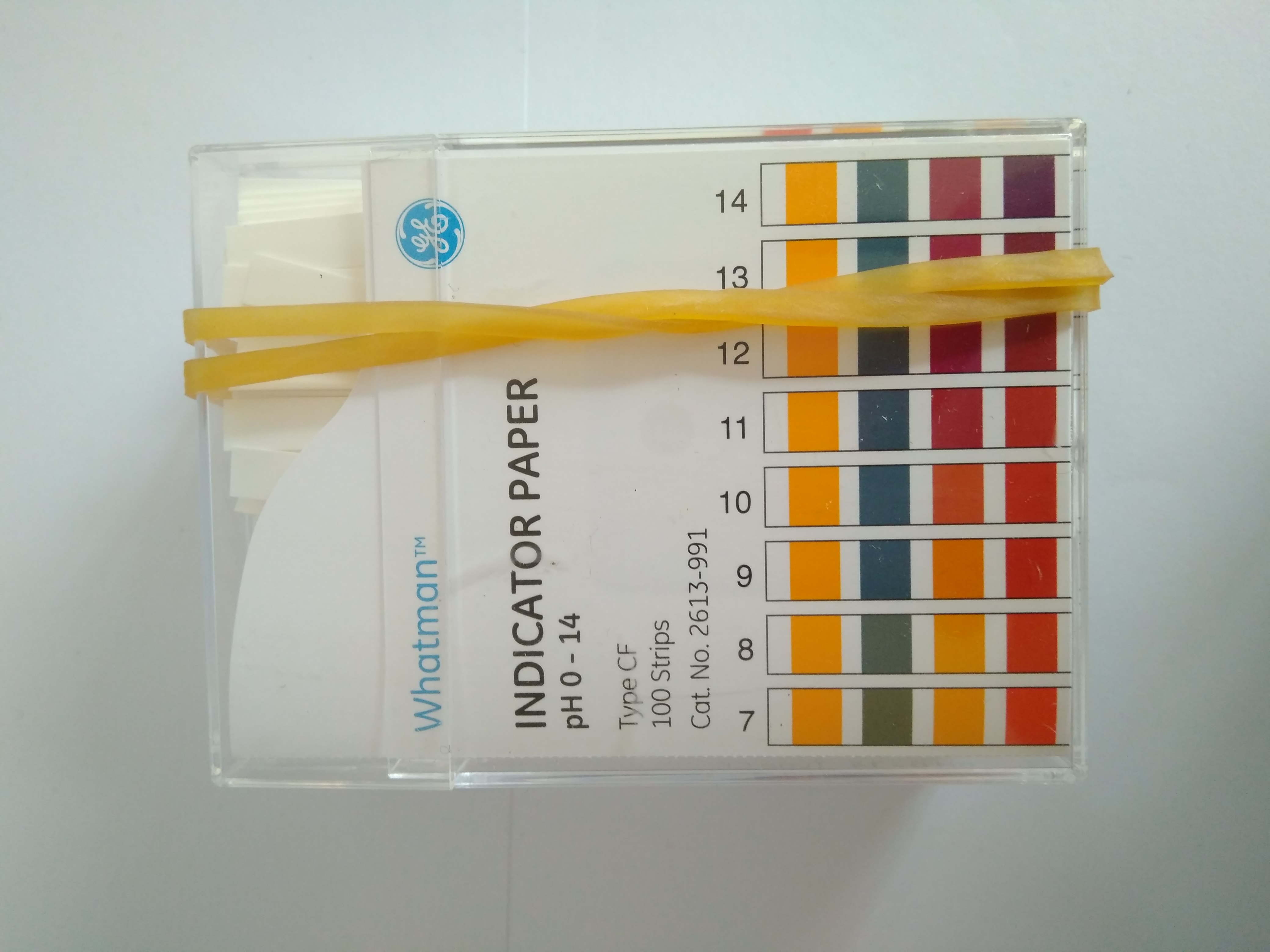
exo-α-Sialidase (Salmonella typhimurium) exo-α-Sialidase (Salmonella typhimurium) 货号:E-SIALST Megazyme中文站
exo-α-Sialidase (Salmonella typhimurium)
英文名:exo-α-Sialidase (Salmonella typhimurium)
货号:E-SIALST
规格:250 Units
High purity recombinant exo-alpha-Sialidase (S. Typhimurium) for use in research, biochemical enzyme assays and in vitro diagnostic analysis.
EC 3.2.1.18
CAZY Family: GH33
Recombinant. From Salmonella typhimurium. In solution (Tris.HCl / NaCl / EDTA).
Hydrolysis of unbranched, non-reducing terminal α-2,3-linked >> α-2,6-linked >> α-2,8-linked N-acetylneuraminic acid (NANA; Neu5Ac) residues from glycoproteins and oligosaccharides of glycoconjugates.
Specific activity: ~ 750 U/mg (37oC, pH 7.0 on pNP-α-D-N-acetylneuraminic acid)
Store at 4oC.
暂无问题解答
暂无视频
康宁corning 431111 DISH,245X245MM,NT,PS,S,BK,4/16 培养皿 245X245MM 未处理表面 PS(聚苯乙烯)材质 大包装 (cf 430599/430167/430293/431110/431112) 4个/包
康宁corning 431111 DISH,245X245MM,NT,PS,S,BK,4/16
培养皿 245X245MM 未处理表面 PS(聚苯乙烯)材质 大包装 (cf 430599/430167/430293/431110/431112) 4个/包 4包/箱 1530.07
Whatman 滤膜 10463875 UNIFLO 13/0.2 RC 1000/PK
Whatman 滤膜 10463875 UNIFLO 13/0.2 RC 1000/PK UNIFLO 13/0.2 RC 1000/PK
Pall颇尔滤膜 72971 UNDERDRAIN DISC 47MM
Pall颇尔滤膜 72971 UNDERDRAIN DISC 47MM 71 568
康宁corning 3635 PLATE,96WL,UV,FB,PS,WO/LID,NS 96孔板 UV-透明平底 带盖 未灭菌 25个/包
康宁corning 3635 PLATE,96WL,UV,FB,PS,WO/LID,NS
96孔板 UV-透明平底 带盖 未灭菌 25个/包 2包/箱 7582.58
二乙酰壳二糖 Diacetyl-Chiotobiose – 30mg 货号:O-CHI2 Megazyme中文站
二乙酰壳二糖
英文名:Diacetyl-Chiotobiose – 30mg
货号:O-CHI2
规格:30 mg
CAS: 35061-50-8
Molecular Formula: C16H28N2O11
Molecular Weight: 424.4
Purity: > 95%
High purity Diacetyl-chitobiose for use in research, biochemical enzyme assays and in vitro diagnostic analysis.
Prepared from chitin.
暂无问题解答
暂无视频
Whatman 滤膜 6709-3602 囊式滤器Polycap AS 36, 0.2m 1/盒
Whatman 滤膜 6709-3602 囊式滤器Polycap AS 36, 0.2m 1/盒 POLYCAP 36 0.2 AS 1/PK F/A S
Whatman 滤膜 29168174 602 H 1/2 Folded Filters, 150 mm, 100/pk – PROMO
Whatman 滤膜 29168174 602 H 1/2 Folded Filters, 150 mm, 100/pk – PROMO 602 H 1/2 Folded Filters, 150 mm, 100/pk – PROMO
BioVendor品牌代理商
BioVendor品牌代理商–上海金畔
1. BioVendor品牌介绍
BioVendor 是欧洲的一家医药科技公司,专注于为分子和细胞学实验室提供体外研究产品,主要产品有重组蛋白、抗体和 ELISA 试剂盒。目前公司致力于有关激素和细胞活素利用方面的研究
,产品相关方向:能量代谢和体重调节、骨代谢、心血管疾病和肾病、感染和发炎、铁代谢研究、肌肉生长控制、神经组织损坏标记、肿瘤学、胰腺调节分子、分泌型磷脂酶 A2等。
2. BioVendor重点产品
重组蛋白、抗体和 ELISA 试剂盒
3. BioVendor官网
http://www.biovendor.com
4. 金畔生物代理BioVendor品牌联系方式
Bio-rad品牌代理商–上海金畔
1. Bio-rad品牌介绍
美国伯乐BIO-RAD公司公司总部设在美国加里福尼亚州的Hercules,在全球有30多家全资子公司,服务于全球超过85,000家科研院所,生物技术和制药公司,和临床实验室。
BIO-RAD公司自1952年成立以来,在50多年中为临床诊断和生命科学研究市场提供了广泛的新型产品和服务,始终居于科学发现的中心地位。 BIO-RAD公司 现今利用多种技术制造并
生产了几千种产品,这些技术包括蛋白质组学、生物信息学、电泳、成像、免疫测定、层析、微生物学和基因转移。根据产品的不同,BIO-RAD公司公司下设三大部门,它们是生命科学部,临
床诊断部和工业材料部,产品种类达6000余种。BIO-RAD公司主要产品有蛋白组研究产品、层析仪与填料、蛋白质和核酸电泳产品、基因枪与电穿孔仪、定量基因扩增仪、图像分析系统、激光
共聚焦扫描显微镜、酶标仪和洗板机系列、食品检测仪器与试剂、糖化血红蛋白检测系列产品、质控系统、毒物检测产品、血液病毒检测产品等。
2. Bio-rad重点产品
生命科学试剂
临床诊断试剂
3. Bio-rad官网
www.bio-rad.com
4. 金畔生物代理Bio-rad品牌联系方式
上海金畔生物科技有限公司
地 址: 上海市浦东新区东靖路699弄36栋701室
邮 编: 201208
qq: 2743691513
固话总机:021-50837765
订货热线:15221999938
网 址: www.jinpanbio.com
Email:sales@jinpanbio.com
Whatman 滤膜 1005-125 5号滤纸圆型125mm/100
Whatman 滤膜 1005-125 5号滤纸圆型125mm/100 GR 5 12.5CM 100/PK
康宁corning 40006 CMT-GAPS2 COATED SLIDES,NON BA GAPS2包被载玻片 无条形码 大包装 25个/包
康宁corning 40006 CMT-GAPS2 COATED SLIDES,NON BA
GAPS2包被载玻片 无条形码 大包装 25个/包 1包/箱 6727.12
BD培养基 212346 500 g EA BBL Mycoplasma Broth Base (Frey) 支原体属肉汤基础(Frey)
BD培养基 212346 500 g EA BBL Mycoplasma Broth Base (Frey) 支原体属肉汤基础(Frey) 
Whatman 滤膜 10541115 BA79 115x80MM 25/PK
Whatman 滤膜 10541115 BA79 115x80MM 25/PK BA79 115x80MM 25/PK
Pall颇尔滤膜 4632 VACUCAP 60 0.2UM STERILE PK10
Pall颇尔滤膜 4632 VACUCAP 60 0.2UM STERILE PK10 214 1712
OXOID培养基 CM1036B Brilliance蜡样芽孢杆菌显色琼脂基础 CHROMOGENIC BACILLUS CEREUS AGAR BAS
OXOID培养基 CM1036B Brilliance蜡样芽孢杆菌显色琼脂基础 CHROMOGENIC BACILLUS CEREUS AGAR BAS 2353.97105632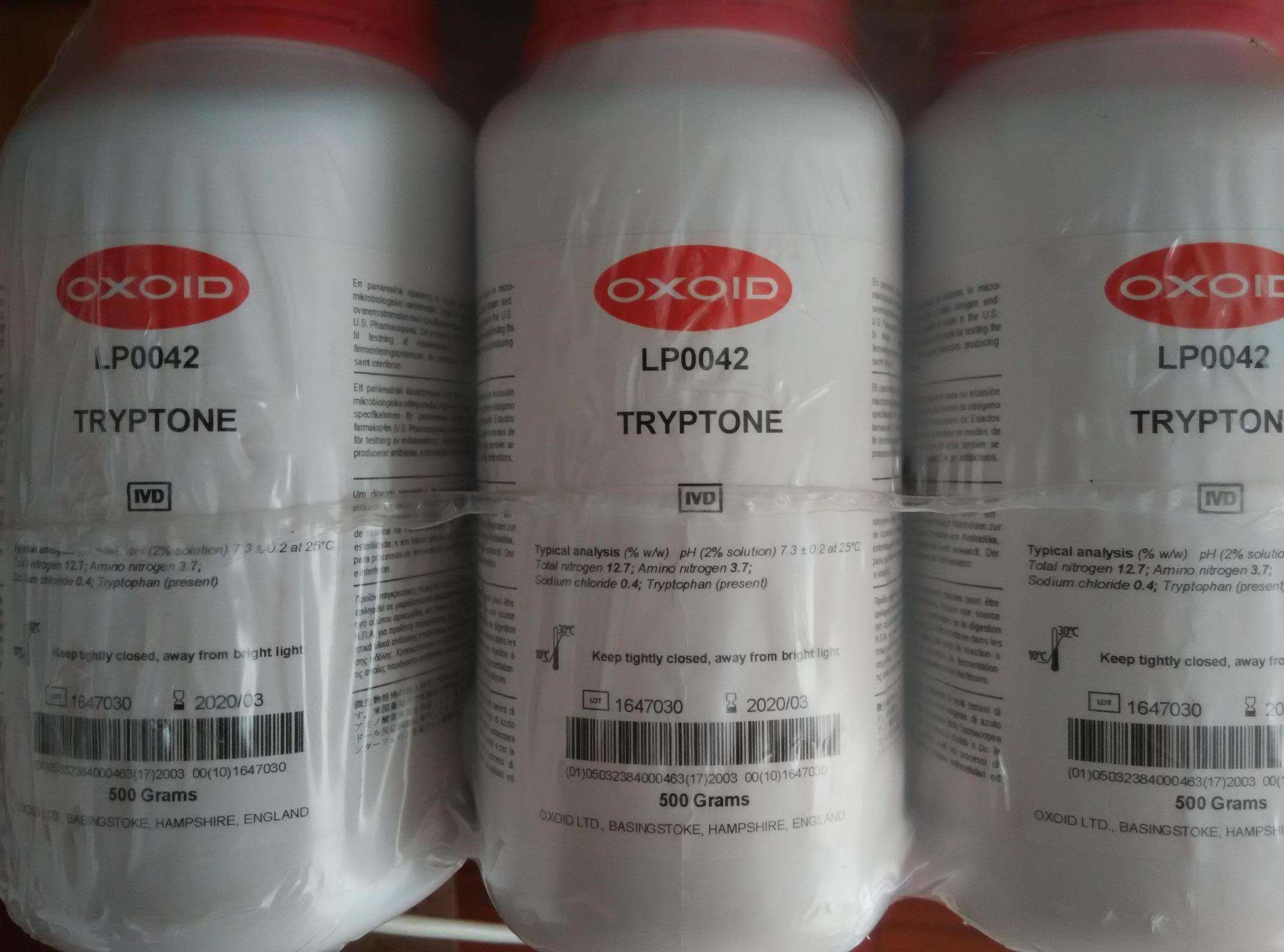
Axygen PCR-0108-LP-RT-C 0.1mlPCR无色薄壁8联管(含平盖) 125排/包,10包/箱
Axygen PCR-0108-LP-RT-C 0.1mlPCR无色薄壁8联管(含平盖) 125排/包,10包/箱 12459.01 
OXOID培养基 CM0996B LURIA BROTH BASE (MILLERS) 500G
OXOID培养基 CM0996B LURIA BROTH BASE (MILLERS) 500G 504.446003712
4-甲基-SS-木二糖 4-Methylumbelliferyl-Beta-Xylobioside 货号:O-4MUX2-5MG Megazyme中文站
4-甲基-SS-木二糖
英文名:4-Methylumbelliferyl-Beta-Xylobioside
货号:O-4MUX2-5MG
规格:5mg
CAS: 158962-91-5
Molecular Formula: C20H24O11
Molecular Weight: 440.4
Purity: > 98%
High purity 4-Methylumbelliferyl-β-xylobioside for use in research, biochemical enzyme assays and in vitro diagnostic analysis.
A fluorogenic substrate for assay of xylanase and xlyosidase activity.
Data booklets for each pack size are located in the Technical Resources tab.
暂无问题解答
暂无视频
木聚糖酶ATF检测底物 Xylazyme ATF (40mg) 1000 tablets 货号:T-XYZATF Megazyme中文站
木聚糖酶ATF检测底物
英文名:Xylazyme ATF (40mg) 1000 tablets
货号:T-XYZATF
规格:1000 tablets
暂无详情描述
暂无问题解答
暂无视频
康宁corning 431408 FLASK,ERLENMEYER,500mL,BAFFLED 三角培养瓶500ml 缓冲底 密闭盖 灭菌 1个/包
康宁corning 431408 FLASK,ERLENMEYER,500mL,BAFFLED
三角培养瓶500ml 缓冲底 密闭盖 灭菌 1个/包 25包/箱 3927.69
Pall颇尔滤膜 8040 FILTER PLATE 3UM GF/1.2 SUPOR
Pall颇尔滤膜 8040 FILTER PLATE 3UM GF/1.2 SUPOR 352 2813
